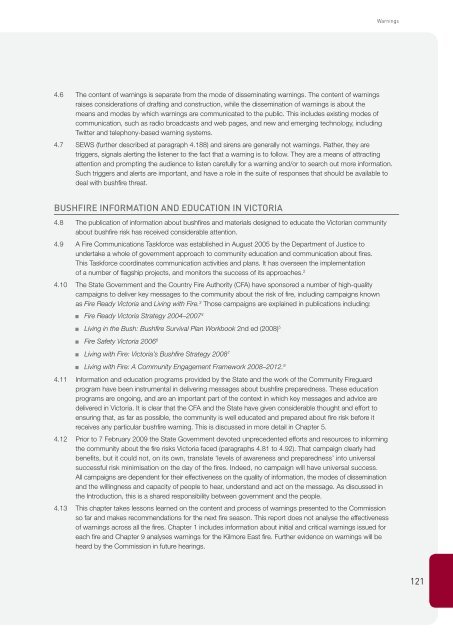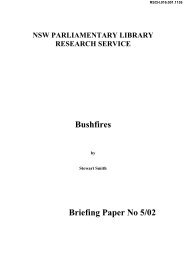Chapter 4 - Warnings - 2009 Victorian Bushfires Royal Commission
Chapter 4 - Warnings - 2009 Victorian Bushfires Royal Commission
Chapter 4 - Warnings - 2009 Victorian Bushfires Royal Commission
Create successful ePaper yourself
Turn your PDF publications into a flip-book with our unique Google optimized e-Paper software.
<strong>Warnings</strong><br />
4.6<br />
4.7<br />
The content of warnings is separate from the mode of disseminating warnings. The content of warnings<br />
raises considerations of drafting and construction, while the dissemination of warnings is about the<br />
means and modes by which warnings are communicated to the public. This includes existing modes of<br />
communication, such as radio broadcasts and web pages, and new and emerging technology, including<br />
Twitter and telephony-based warning systems.<br />
SEWS (further described at paragraph 4.188) and sirens are generally not warnings. Rather, they are<br />
triggers, signals alerting the listener to the fact that a warning is to follow. They are a means of attracting<br />
attention and prompting the audience to listen carefully for a warning and/or to search out more information.<br />
Such triggers and alerts are important, and have a role in the suite of responses that should be available to<br />
deal with bushfire threat.<br />
BUSHFIRE INFORMATION AND EDUCATION IN VICTORIA<br />
4.8<br />
4.9<br />
4.10<br />
4.11<br />
4.12<br />
4.13<br />
The publication of information about bushfires and materials designed to educate the <strong>Victorian</strong> community<br />
about bushfire risk has received considerable attention.<br />
A Fire Communications Taskforce was established in August 2005 by the Department of Justice to<br />
undertake a whole of government approach to community education and communication about fires.<br />
This Taskforce coordinates communication activities and plans. It has overseen the implementation<br />
of a number of flagship projects, and monitors the success of its approaches. 2<br />
The State Government and the Country Fire Authority (CFA) have sponsored a number of high-quality<br />
campaigns to deliver key messages to the community about the risk of fire, including campaigns known<br />
as Fire Ready Victoria and Living with Fire. 3 Those campaigns are explained in publications including:<br />
■■<br />
Fire Ready Victoria Strategy 2004–2007<br />
■■<br />
Living in the Bush: Bushfire Survival Plan Workbook 2nd ed (2008) 5<br />
■■<br />
■■<br />
■■<br />
Fire Safety Victoria 2006<br />
Living with Fire: Victoria’s Bushfire Strategy 2008<br />
6<br />
Living with Fire: A Community Engagement Framework 2008–2012.<br />
4<br />
Information and education programs provided by the State and the work of the Community Fireguard<br />
program have been instrumental in delivering messages about bushfire preparedness. These education<br />
programs are ongoing, and are an important part of the context in which key messages and advice are<br />
delivered in Victoria. It is clear that the CFA and the State have given considerable thought and effort to<br />
ensuring that, as far as possible, the community is well educated and prepared about fire risk before it<br />
receives any particular bushfire warning. This is discussed in more detail in <strong>Chapter</strong> 5.<br />
7<br />
Prior to 7 February <strong>2009</strong> the State Government devoted unprecedented efforts and resources to informing<br />
the community about the fire risks Victoria faced (paragraphs 4.81 to 4.92). That campaign clearly had<br />
benefits, but it could not, on its own, translate ‘levels of awareness and preparedness’ into universal<br />
successful risk minimisation on the day of the fires. Indeed, no campaign will have universal success.<br />
All campaigns are dependent for their effectiveness on the quality of information, the modes of dissemination<br />
and the willingness and capacity of people to hear, understand and act on the message. As discussed in<br />
the Introduction, this is a shared responsibility between government and the people.<br />
This chapter takes lessons learned on the content and process of warnings presented to the <strong>Commission</strong><br />
so far and makes recommendations for the next fire season. This report does not analyse the effectiveness<br />
of warnings across all the fires. <strong>Chapter</strong> 1 includes information about initial and critical warnings issued for<br />
each fire and <strong>Chapter</strong> 9 analyses warnings for the Kilmore East fire. Further evidence on warnings will be<br />
heard by the <strong>Commission</strong> in future hearings.<br />
8<br />
121
















